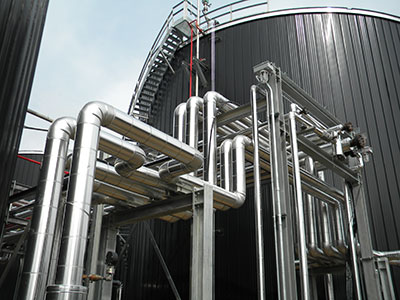Cold, wet, or extreme heat can break down even the toughest insulation—but not all insulation is made equal. Let me clear up some confusion about cellular glass.
Cellular glass insulation is a strong, lightweight, closed-cell material known for its moisture resistance, fire safety, and durability. It is used to insulate tanks, pipes, and buildings where reliability is needed, and it does not absorb water.

Some insulation types fail after only a few years, causing headaches and higher maintenance. Cellular glass stands out for performance you can depend on. It is good for chemical plants, cryogenic tanks, and places where the wrong material can mean a costly problem later. Read on to see the real differences, how to choose the right type, and when you want cellular glass most.
What type of insulation is cellular glass?
When moisture or fire is around, some materials just cannot handle it. Cellular glass is different because of its unique structure.
Cellular glass insulation is made from crushed glass melted and expanded with a foaming agent, creating a rigid, closed-cell material that does not absorb water or support combustion. It is classified as inorganic, non-combustible, and extremely resistant to corrosion under insulation.

Cellular glass is an inorganic insulation. This means it is made without organic ingredients that break down or attract mold. The base is glass powder, which is mixed with a blowing agent. It gets heated, foams up like bread in an oven, and forms millions of tiny, sealed glass bubbles. These bubbles make the material light and give it the closed-cell structure that blocks water and vapor. That means it will not rot, absorb liquid, or burn if exposed to flames. For tank insulation, this closed structure is what keeps tanks protected for decades with almost no maintenance. When compared with other insulation materials like fiberglass or foam, cellular glass does much better when chemical resistance and fireproofing matter most. I have seen it in chemical factories and LNG terminals where it does not just extend lifespan but gives engineers peace of mind.
What are the different types of cellular insulation?
Not all cellular insulation is made the same. Choosing the right type depends on what you need—some are soft, some rigid, some can burn or soak up water, and others, like cellular glass, cannot.
The main types of cellular insulation include cellular glass, cellular rubber, and cellular plastic. Cellular glass stands out for its fire resistance and water tightness, while rubber and plastic types are more flexible but less fireproof and can absorb water depending on structure.

Let me break this down. Cellular insulation means the material’s base is packed with tiny air cells. That air traps heat, stopping it from moving from one side to the other. Cellular glass is the premium option when fire, water, and chemicals are worries. It is stiff, non-flammable, closed-cell, and does not soak up moisture. Cellular rubber, made from synthetic rubber, is flexible and soft but can support fire unless treated. It is often used for cold pipes or small tanks but not where you need high fire safety. Cellular plastic, usually polyurethane or polyisocyanurate foam, is lightweight and holds heat in well, but it can catch fire and is vulnerable to water if its protective layer gets damaged. In my work with heavy industry, cellular glass is the “gold standard” for places that need the best safety and longest system life. It is the most reliable against leaks, fire, and harsh chemicals.
What is the R-value of cellular glass insulation?
R-value is how we measure how well insulation keeps heat in or out. The higher the R-value, the better it slows heat transfer, helping control energy loss.
Cellular glass insulation has an R-value of about 3.3 to 3.8 per inch, giving it strong thermal performance for both cold and hot applications. It keeps its R-value even when exposed to moisture and humidity, unlike many other materials.
The R-value tells us how much heat moves through the insulation. For cellular glass, it averages between 3.3 and 3.8 per inch of thickness. This might seem lower than some foams, but there is an important difference—this R-value does not drop with time. Many foams and fibers lose their performance when water soaks in or as air leaks out. I have seen cellular glass used in cold storage and LNG tanks, where its true R-value did not change even after a decade. In my experience, when reliability and consistent thermal performance are more important than chasing the highest possible number on paper, cellular glass is hard to beat.
What is the temperature range for cellular glass insulation?
Some insulation types break down when temperatures rise above a certain point or freeze solid in the cold. In contrast, cellular glass works across an extreme range without degrading.
Cellular glass insulation stays stable from -268°C up to 482°C, making it ideal for cryogenic tanks, steam lines, and high-temperature industrial processes. The structure stays the same, so it won’t shrink, burn, or fall apart under thermal stress.
In a big chemical facility, we once evaluated several options for both extreme cold and hot pipework. Most plastics failed tests below minus 100°C—they went brittle or cracked. On the hot end, some burned or shrank away from the metal. Cellular glass passed with flying colors, staying strong at minus 196°C (liquid nitrogen range) and just as stable above 400°C on steam lines. Its structure does not change. It does not give off toxic gases or break up under heat. In industries where temperatures swing from one extreme to the next, this makes cellular glass the safest long-term solution I have used or recommended.
Conclusion
Cellular glass insulation stands out for chemical resistance, fireproofing, and durability, meeting the toughest industrial needs for safety and efficiency.

